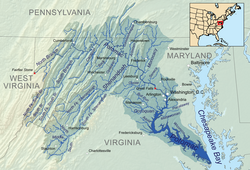Timeline of accomplishments
1940s - The Commission's first (1943) report on the condition of Potomac basin waters precipitates adoption of a pollution abatement program (1945), an intensive survey of industrial pollution (1946), and definition of a set of "Minimum Water Quality Criteria" (1946) by which Potomac streams and waterways may be judged suitable or unsuitable for several principal water uses. Concurrent to Congress enacting the first Federal Water Pollution Control Act (1948), ICPRB initiates a continuous water-quality sampling program in the basin. By 1949, ICPRB is given credit for coordination with local authorities to "radically" improve conditions on the Potomac's Shenandoah River tributary, recently referred to as a "biological desert" due to pollution from industrial waste.
1950s - ICPRB issues a major report describing the polluted Washington area Potomac and publishes the results of a study it sponsored on North Branch industrial wastes (1954). Under the auspices of the ICPRB, a group of citizens organizes the Citizens Council for a Clean Potomac (1956). As the U.S. Public Health Service declares the Potomac River unsafe for swimming, ICPRB estimates that on the average, 60 million cubic feet of sediment is deposited annually within the metropolitan Washington reach of the Potomac estuary (1957). Chairman Harold A. Kemp indicates Potomac River pollution has reached a "critical condition" with urgent need for additional sewage treatment facilities. [7] By 1958, ICPRB is gathering and tabulating information from about 85 stream sampling stations operated by cooperating agencies, municipalities and industries. The following year, ICPRB publishes its first "Potomac River Water Quality Network," holds a "first-of-its-kind" silt control conference and sponsors a study of sediment sources in the basin with the U.S. Geological Survey.
1960s - In 1963, ICPRB issues two reports on sediment sources and an urban sediment control program.
1970s - ICPRB's Compact is amended in 1970, extending its authority to include water supply and water-related land use. In 1975, an ICPRB conference focuses on rising dollar and energy costs associated with Washington, D.C. metro area sewage treatment. Low Flow Allocation Agreement established in 1978.
1980s - ICPRB initiates regional discussion of the problem posed by invasive aquatic weed, hydrilla (1983). After Maryland (1985) and the District of Columbia (1986) initiate a phosphate detergent bans, ICPRB recommends (1987) expanding such bans basin-wide.
1990s - Maryland, West Virginia and ICPRB sign (1993) cooperative agreement on program to restore water quality to the North Branch. [8] [9]
2000s– In 2001, the ICPRB combined decades of data into a consistent and usable format for researchers and those working on the watershed in the Tidal Potomac Integrative Analysis Project. In 2002, ICPRB's successful American Shad Restoration Project is completed, restoring the population of this historically significant fish that once flowed freely in the Potomac but had been decimated by pollution, overfishing, and blockage over the past century. In 2004, along with other partners in the basin, the Commission organizes and leads the formation of a voluntary partnership between water utilities and state and federal agencies known as the Potomac River Basin Drinking Water Source Protection Partnership which will focus on protecting the water quality of the river as the source of drinking water for millions of people that live in the basin. ICPRB developed an index of stream health known as "Chessie BIBI" in 2008. The index is calculated from stream macroinvertebrate samples collected and counted by state, federal, and local agencies and other groups.
2010s - In 2011, scientists at ICPRB conduct a survey of freshwater mussels in the mainstem of the River. These sensitive creatures are good indicators of a healthy waterway. Having baseline information can help determine the future shifts in water quality. The Potomac River Basin Comprehensive Water Resources Plan is adopted in 2018. The plan, updated in 2023, describes a shared vision for the basin, identifies water resources issues of interstate and/or basin wide significance, and recommends actions for achieving the shared vision. [10]
2020s - A 2024 ICPRB report warns of widespread public risks and costs if contamination, drought or infrastructure damage compromises use of the Potomac River as a drinking water source. [11] [12]


